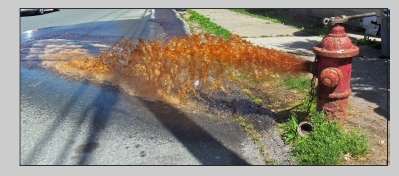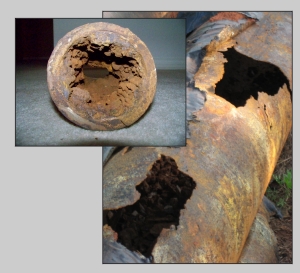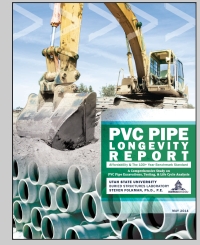|
 The
Pittsburgh, PA water and sewer authority, which only uses iron pipes in its
water system, has become a source of mounting discontent and has been called a
“failed organization.” Lead has been detected in Pittsburgh’s drinking water as
is the case with many other cities that allow only iron pipes in their water
systems – places like Milwaukee, WI, New York, NY, Providence, RI, Portland, OR,
Boston, MA, Philadelphia, PA, St. Paul, MN, and Chicago, IL to name a few. These
cities are all members of the iron pipe industry’s “Century Club.” Like many
municipalities that do not allow competitive bidding for water piping and
exclusively use iron pipe (Flint, MI included), Pittsburgh is plagued with
higher water main breaks, higher operating costs and higher utility rates, as
well as water quality issues like rusty water, lead and an increased danger of
pathogens entering the water supply.
Click here for the article, “Pittsburgh Joins the List of U.S. Cities with
Lead in Drinking Water. The
Pittsburgh, PA water and sewer authority, which only uses iron pipes in its
water system, has become a source of mounting discontent and has been called a
“failed organization.” Lead has been detected in Pittsburgh’s drinking water as
is the case with many other cities that allow only iron pipes in their water
systems – places like Milwaukee, WI, New York, NY, Providence, RI, Portland, OR,
Boston, MA, Philadelphia, PA, St. Paul, MN, and Chicago, IL to name a few. These
cities are all members of the iron pipe industry’s “Century Club.” Like many
municipalities that do not allow competitive bidding for water piping and
exclusively use iron pipe (Flint, MI included), Pittsburgh is plagued with
higher water main breaks, higher operating costs and higher utility rates, as
well as water quality issues like rusty water, lead and an increased danger of
pathogens entering the water supply.
Click here for the article, “Pittsburgh Joins the List of U.S. Cities with
Lead in Drinking Water.
Drug-Resistant Germs Thrive in
Corroded Iron Water Pipes
“The thousands of miles of aging, corroding pipes that bring water to Americans
each day may be home to dangerous drug-resistant bacteria, a new report warns.
These harmful bacteria include legionella, which causes Legionnaires' disease;
pseudomonas, which can trigger pneumonia; and mycobacteria, which can cause
tuberculosis and other illnesses, the researchers said. While these bacteria
thrive in many environments, they "can [also] live in the pipes..."
Click here
to read article.
The Real Story About DIPRA’s
Century Club -- An Example Not to Follow

In response to loss of market share and growing concerns about the safety and
performance of iron piping systems, the Ductile Iron Pipe Research Association (DIPRA)
likes to call attention to cities in America that have used cast iron pipes for
100 years – called the Century Club – claiming that newer versions of
old-technology iron pipe will last as long. It’s well known that cast iron pipes
become degraded by corrosion, with attendant public health and safety issues,
and their service life expires decades short of the century mark, resulting in
water main breaks, water quality issues, expensive maintenance and higher
operating costs for much of the time they are ‘in service.’ They then equate the
‘longevity’ of these pipes to ductile iron ones - which are thinner, even less
durable, and have an even shorter lifespan. A 2011 report by the American Water
Works Association found that thin-walled iron pipes (representing the majority
of metallic pipes sold) in moderately corrosive soils have a life expectancy of
only 11-14 years. The finding is significant considering that 75 percent of all
water utilities operate in corrosive soil conditions. A University of Michigan-DIPRA
‘study’ titled, “Framework to Evaluate the Life Cycle Costs and Environmental
Impacts of Water Pipelines,” tries to reframe iron pipe’s increasingly
problematic narrative.
Iron Pipe Industry ‘Study’
Violates Basic Principles of Scientific Research Says Water Industry Expert Dr.
Bonner Cohen
 Water
industry expert Dr. Bonner Cohen warns utilities, local lawmakers and policy
makers of the significant flaws in the University of Michigan-DIPRA ‘study’ in
the article, “Infrastructure: The problem is real, but so are hidden agendas,”
which was featured in The Washington Examiner. Cohen says the ‘study’ could have
provided valuable guidance to municipalities struggling with critical
procurement decisions related to upgrading their water systems. Instead, the
paper’s three authors violated the basic principles of scientific research.
Specifically, in comparing the longevity of ductile iron and PVC pipes, they
claim that the life of PVC pipe is 41-60 years, citing a 2012 report by Dr.
Steven Folkman, director of Utah State University’s Buried Structures
Laboratory. Dr. Folkman made no such statement in the study and is on record, in
a 2014 report, at putting the service life of PVC pipe “in excess of 100 years.”
In a recent letter to the University of Michigan Professor Folkman cites 15
additional studies from around the world attesting to PVC pipe’s 100-year plus
longevity and performance. Water
industry expert Dr. Bonner Cohen warns utilities, local lawmakers and policy
makers of the significant flaws in the University of Michigan-DIPRA ‘study’ in
the article, “Infrastructure: The problem is real, but so are hidden agendas,”
which was featured in The Washington Examiner. Cohen says the ‘study’ could have
provided valuable guidance to municipalities struggling with critical
procurement decisions related to upgrading their water systems. Instead, the
paper’s three authors violated the basic principles of scientific research.
Specifically, in comparing the longevity of ductile iron and PVC pipes, they
claim that the life of PVC pipe is 41-60 years, citing a 2012 report by Dr.
Steven Folkman, director of Utah State University’s Buried Structures
Laboratory. Dr. Folkman made no such statement in the study and is on record, in
a 2014 report, at putting the service life of PVC pipe “in excess of 100 years.”
In a recent letter to the University of Michigan Professor Folkman cites 15
additional studies from around the world attesting to PVC pipe’s 100-year plus
longevity and performance.
Click here
to read Dr. Cohen’s article.
Click here
for Dr. Folkman’s letter to the University of Michigan.
Click here
to view the 2014 PVC Pipe Longevity Report referenced above.
Assumptions and Modelling Used in
‘Study’ Deeply Flawed
The DIPRA ‘study’ also claims that ductile iron pipe has a life expectancy of
100 years. DIPRA, on its own website, puts the life cycle of today’s thin-walled
ductile iron pipes at 50 years. As well, the ‘study’ suggests that the pumping
efficiency of ductile iron pipe remains constant for 100 years, though data from
the City of Detroit and the Washington Suburban Sanitary Commission shows that
its pumping efficiency declines with age.
Click here
for 2015 Detroit Water Master Plan C-Factor
 Projections
Study - Appendix H. Projections
Study - Appendix H.
Below are excerpts from a number of additional
articles of interest to water utility professionals and local lawmakers alike.
Avoiding the Road to Flint
“The nation’s corroded iron piping systems have
become too risky to operate safely. They are a breeding ground for pathogens.
Water systems are capital intensive operations, where every dollar spent on
plugging leaks and fighting a losing war against corrosion is a dollar not
invested in upgrading life-sustaining water networks. One way municipalities can
lessen the financial burdens facing them is to remove the barriers many of them,
including Flint, have that keep providers of cost-effective, innovative
technologies and products from participating in the competitive bidding process
for pipe replacement.”
Click here for article.
State of Ohio Looking at Open Bidding for Water and Sewer Pipe
“As several communities across Ohio
struggle with water quality concerns, it is clear that our state’s crumbling and
corroded clean-water pipe infrastructure needs significant upgrades. Even as the
legislature and the Ohio Environmental Protection Agency work to eliminate
instances of lead contamination in drinking water and fight toxic algae in
lakes, rivers and streams, other long-term issues remain. There are troubling
reports of water mains breaking across Ohio. More than 93,000 breaks occurred
between Columbus and Portsmouth from 2000 to 2006 alone…The U.S. EPA has
projected it will cost more than $12 billion over the next two decades to
upgrade water infrastructure in Ohio. Most of the infrastructure-related money —
about $8 billion — will be needed for the network of pipes that distribute
water… Much of the funding for these projects will come from state
coffers...House Bill 214, currently being deliberated in the Ohio House,
addresses lingering water infrastructure concerns by injecting free-market and
open competition principles to local drinking-water pipe-overhaul projects.”
Click here for article.
 Regards, Regards,
Bruce Hollands
Executive
Director | Uni-Bell PVC Pipe Association
2711 LBJ Freeway, Suite
1000 | Dallas, TX 75234
T. 972.243.3902 ext. 1019 | F.
972.243.3907
www.uni-bell.org
  
|